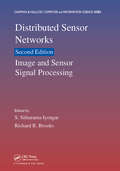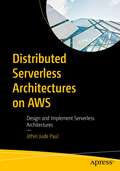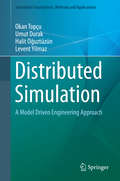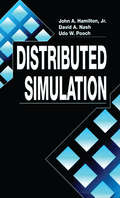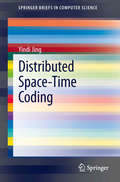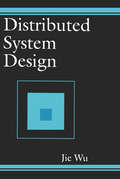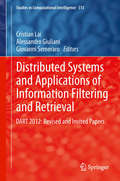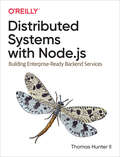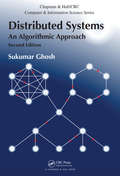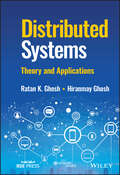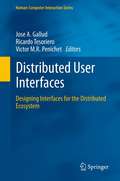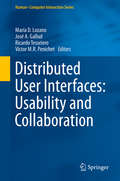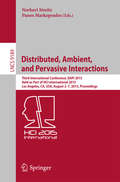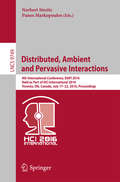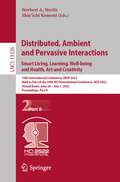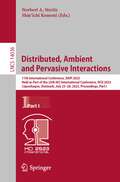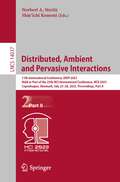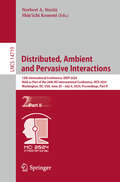- Table View
- List View
Distributed Sensor Networks: Image and Sensor Signal Processing (Volume One) (Chapman And Hall/crc Computer And Information Science Ser. #26)
by S. Sitharama Iyengar Richard R. BrooksThe best-selling Distributed Sensor Networks became the definitive guide to understanding this far-reaching technology. Preserving the excellence and accessibility of its predecessor, Distributed Sensor Networks, Second Edition once again provides all the fundamentals and applications in one complete, self-contained source. Ideal as a tutorial for
Distributed Sensor Networks: Sensor Networking and Applications (Volume Two) (Chapman & Hall/CRC Computer and Information Science Series)
by S. Sitharama Iyengar Richard R. BrooksThe best-selling Distributed Sensor Networks became the definitive guide to understanding this far-reaching technology. Preserving the excellence and accessibility of its predecessor, Distributed Sensor Networks, Second Edition once again provides all the fundamentals and applications in one complete, self-contained source. Ideal as a tutorial for
Distributed Serverless Architectures on AWS: Design and Implement Serverless Architectures
by Jithin Jude PaulExplore the serverless world using Amazon Web Services (AWS) and develop various architectures, including those for event-driven and disaster recovery designs. This book will give you an understanding of different distributed serverless architectures and how to build them using AWS components. You will begin with an introduction to serverless components and architectures, before progressing to data platforms and containers. Next, you'll dig deeper into these serverless architectures and how they leverage AWS components through practical use cases. You will also explore designing systems in a multi-cloud paradigm. Author Jithin Jude Paul then demonstrates how efficient serverless architectures are, and the benefits of designing distributed systems globally in a cost-effective way while incorporating a microservices architectural style. Distributed Serverless Architectures with AWS concludes with a discussion of current and future trends in serverless frameworks. After completing this book, you'll be able to design distributed serverless architectures using AWS.What You'll LearnGain an overview of different serverless architectures Design and build distributed systems using serverless componentsBuild serverless data and container platforms on AWSPlan a multi-cloud strategy using serverless components Who This Book Is For Cloud engineers, DevOps engineers, and architects focused on the AWS ecosystem, as well as software engineers/developers working with AWS.
Distributed Simulation
by Okan Topçu Umut Durak Halit Oğuztüzün Levent YilmazThis uniquetext/reference provides a comprehensive review of distributed simulation (DS)from the perspective of Model Driven Engineering (MDE), illustrating how MDEaffects the overall lifecycle of the simulation development process. Numerouspractical case studies are included to demonstrate the utility andapplicability of the methodology, many of which are developed from toolsavailable to download from the public domain. Topics and features: Provides a thorough introduction to the fundamental concepts, principles and processes of modeling and simulation, MDE and high-level architecture Describes a road map for building a DS system in accordance with the MDE perspective, and a technical framework for the development of conceptual models Presents a focus on federate (simulation environment) architectures, detailing a practical approach to the design of federations (i. e. , simulation member design) Discusses the main activities related to scenario management in DS, and explores the process of MDE-based implementation, integration and testing Reviews approaches to simulation evolution and modernization, including architecture-driven modernization for simulation modernization Examines the potential synergies between the agent, DS, and MDE methodologies, suggesting avenues for future research at the intersection of these three fields Distributed Simulation -A Model Driven Engineering Approach is an important resource for allresearchers and practitioners involved in modeling and simulation, and softwareengineering, who may be interested in adopting MDE principles when developingcomplex DS systems.
Distributed Simulation (Computer Science And Engineering Ser.)
by Udo W. Pooch John A. Hamilton David A. NashSimulation is a multi-disciplinary field, and significant simulation research is dispersed across multiple fields of study. Distributed computer systems, software design methods, and new simulation techniques offer synergistic multipliers when joined together in a distributed simulation. Systems of most interest to the simulation practitioner are often the most difficult to model and implement. Distributed Simulation brings together the many complex technologies for distributed simulation. There is strong emphasis on emerging simulation methodologies, including object-oriented, multilevel, and multi-resolution simulation. Finally, one concise text provides a strong foundation for the development of high fidelity simulations in heterogeneous distributed computing environments!
Distributed Space-Time Coding
by Yindi JingDistributed Space-Time Coding (DSTC) is a cooperative relaying scheme that enables high reliability in wireless networks. This brief presents the basic concept of DSTC, its achievable performance, generalizations, code design, and differential use. Recent results on training design and channel estimation for DSTC and the performance of training-based DSTC are also discussed.
Distributed Storage Networks
by Thomas C. JepsenThe worldwide market for SAN and NAS storage is anticipated to grow from US $2 billion in 1999 to over $25 billion by 2004. As business-to-business and business-to-consumer e-commerce matures, even greater demands for management of stored data will arise.With the rapid increase in data storage requirements in the last decade, efficient management of stored data becomes a necessity for the enterprise. A recent UC-Berkeley study predicts that 150,000 terabytes of disk storage will be shipped in 2003. Most financial, insurance, healthcare, and telecommunications institutions are in the process of implementing storage networks that are distributed to some degree. For these institutions, data integrity is critical, and they will spend much time and money on planning.One of the primary obstacles to implementing a storage network cited by enterprise IT managers is a lack of knowledge about storage networking technology and the specific issues involved in extending a Storage Area Network (SAN) or Network Attached Storage (NAS) over the Metropolitan Area Networks (MAN) or Wireless Area Networks (WAN). Distributed Storage Networks : Architecture, Protocols and Management addresses the "terminology gap" between enterprise network planners and telecommunications engineers, who must understand the transport requirements of storage networks in order to implement distributed storage networks. Jepsen comprehensively provides IT managers, planners, and telecommunications professionals with the information they need in order to choose the technologies best suited for their particular environment.* Addresses a hot topic that will become increasingly important in the coming years* Enables high-level managers and planners to make intelligent decisions about network needs.* Includes example network configurations providing solutions to typical user scenarios* Fills the "terminology gap" between enterprise network managers and telecommunications engineers who must understand the transport requirements of storage networks in order to implement distributed storage area networksA fundamental resource for all network managers, planners and network design engineers, as well as telecommunications engineers and engineering, computer science, and information technology students.
Distributed System Design
by Jie WuFuture requirements for computing speed, system reliability, and cost-effectiveness entail the development of alternative computers to replace the traditional von Neumann organization. As computing networks come into being, one of the latest dreams is now possible - distributed computing. Distributed computing brings transparent access to as much computer power and data as the user needs for accomplishing any given task - simultaneously achieving high performance and reliability.The subject of distributed computing is diverse, and many researchers are investigating various issues concerning the structure of hardware and the design of distributed software. Distributed System Design defines a distributed system as one that looks to its users like an ordinary system, but runs on a set of autonomous processing elements (PEs) where each PE has a separate physical memory space and the message transmission delay is not negligible. With close cooperation among these PEs, the system supports an arbitrary number of processes and dynamic extensions.Distributed System Design outlines the main motivations for building a distributed system, including:inherently distributed applicationsperformance/costresource sharingflexibility and extendibilityavailability and fault tolerancescalabilityPresenting basic concepts, problems, and possible solutions, this reference serves graduate students in distributed system design as well as computer professionals analyzing and designing distributed/open/parallel systems.Chapters discuss:the scope of distributed computing systemsgeneral distributed programming languages and a CSP-like distributed control description language (DCDL)expressing parallelism, interprocess communication and synchronization, and fault-tolerant designtwo approaches describing a distributed system: the time-space view and the interleaving viewmutual exclusion and related issues, including election, bidding, and self-stabilizationprevention and detection of deadlockreliability, safety, and security as well as various methods of handling node, communication, Byzantine, and software faultsefficient interprocessor communication mechanisms as well as these mechanisms without specific constraints, such as adaptiveness, deadlock-freedom, and fault-tolerancevirtual channels and virtual networksload distribution problemssynchronization of access to shared data while supporting a high degree of concurrency
Distributed Systems and Applications of Information Filtering and Retrieval
by Alessandro Giuliani Cristian Lai Giovanni SemeraroThis volume focuses on new challenges in distributed Information Filtering and Retrieval. It collects invited chapters and extended research contributions from the special session on Information Filtering and Retrieval: Novel Distributed Systems and Applications (DART) of the 4th International Conference on Knowledge Discovery and Information Retrieval (KDIR 2012), held in Barcelona, Spain, on 4-7 October 2012. The main focus of DART was to discuss and compare suitable novel solutions based on intelligent techniques and applied to real-world applications. The chapters of this book present a comprehensive review of related works and state of the art. Authors, both practitioners and researchers, shared their results in several topics such as "Multi-Agent Systems", "Natural Language Processing", "Automatic Advertisement", "Customer Interaction Analytics", "Opinion Mining". Contributions have been careful reviewed by experts in the area, who also gave useful suggestions to improve the quality of the volume.
Distributed Systems with Node.js
by Thomas Hunter IIMany companies, from startups to Fortune 500 companies alike, use Node.js to build performant backend services. And engineers love Node.js for its approachable API and familiar syntax. Backed by the world's largest package repository, Node's enterprise foothold is only expected to grow.In this hands-on guide, author Thomas Hunter II proves that Node.js is just as capable as traditional enterprise platforms for building services that are observable, scalable, and resilient. Intermediate to advanced Node.js developers will find themselves integrating application code with a breadth of tooling from each layer of a modern service stack.Learn why running redundant copies of the same Node.js service is necessaryKnow which protocol to choose, depending on the situationFine-tune your application containers for use in productionTrack down errors in a distributed setting to determine which service is at faultSimplify app code and increase performance by offloading work to a reverse proxyBuild dashboards to monitor service health and throughputFind out why so many different tools are required when operating in an enterprise environment
Distributed Systems: An Algorithmic Approach, Second Edition (Chapman And Hall/crc Computer And Information Science Ser.)
by Sukumar GhoshDistributed Systems: An Algorithmic Approach, Second Edition provides a balanced and straightforward treatment of the underlying theory and practical applications of distributed computing. As in the previous version, the language is kept as unobscured as possible-clarity is given priority over mathematical formalism. This easily digestible text:Fea
Distributed Systems: Theory and Applications
by Hiranmay Ghosh Ratan K. GhoshDistributed Systems Comprehensive textbook resource on distributed systems—integrates foundational topics with advanced topics of contemporary importance within the field Distributed Systems: Theory and Applications is organized around three layers of abstractions: networks, middleware tools, and application framework. It presents data consistency models suited for requirements of innovative distributed shared memory applications. The book also focuses on distributed processing of big data, representation of distributed knowledge and management of distributed intelligence via distributed agents. To aid in understanding how these concepts apply to real-world situations, the work presents a case study on building a P2P Integrated E-Learning system. Downloadable lecture slides are included to help professors and instructors convey key concepts to their students. Additional topics discussed in Distributed Systems: Theory and Applications include: Network issues and high-level communication tools Software tools for implementations of distributed middleware. Data sharing across distributed components through publish and subscribe-based message diffusion, gossip protocol, P2P architecture and distributed shared memory. Consensus, distributed coordination, and advanced middleware for building large distributed applications Distributed data and knowledge management Autonomy in distributed systems, multi-agent architecture Trust in distributed systems, distributed ledger, Blockchain and related technologies. Researchers, industry professionals, and students in the fields of science, technology, and medicine will be able to use Distributed Systems: Theory and Applications as a comprehensive textbook resource for understanding distributed systems, the specifics behind the modern elements which relate to them, and their practical applications.
Distributed Time-Sensitive Systems (Industry 5.0 Transformation Applications)
by S. Balamurugan Tanupriya Choudhury Ravi Tomar Rahul Kumar Singh J. C. PatniThe book provides invaluable insights into cutting-edge advancements across multiple sectors of Society 5.0, where contemporary concepts and interdisciplinary applications empower you to understand and engage with the transformative technologies shaping our future. Distributed Time-Sensitive Systems offers a comprehensive array of pioneering advancements across various sectors within Society 5.0, underpinned by cutting-edge technological innovations. This volume delivers an exhaustive selection of contemporary concepts, practical applications, and groundbreaking implementations that stand to enhance diverse facets of societal life. The chapters encompass detailed insights into fields such as image processing, natural language processing, computer vision, sentiment analysis, and voice and gesture recognition and feature interdisciplinary approaches spanning legal frameworks, medical systems, intelligent urban development, integrated cyber-physical systems infrastructure, and advanced agricultural practices. The groundbreaking transformations triggered by the Industry 4.0 paradigm have dramatically reshaped the requirements for control and communication systems in the factory systems of the future. This revolution strongly affects industrial smart and distributed measurement systems, pointing to more integrated and intelligent equipment devoted to deriving accurate measurements. This volume explores critical cybersecurity analysis and future research directions for the Internet of Things, addressing security goals and solutions for IoT use cases. The interdisciplinary nature and focus on pioneering advancements in distributed time-sensitive systems across various sectors within Society 5.0 make this thematic volume a unique and valuable contribution to the current research landscape. Audience Researchers, engineers, and computer scientists working with integrations for industry in Society 5.0
Distributed Tracing in Practice: Instrumenting, Analyzing, and Debugging Microservices
by Austin Parker Daniel Spoonhower Jonathan Mace Ben Sigelman Rebecca IsaacsSince most applications today are distributed in some fashion, monitoring their health and performance requires a new approach. Enter distributed tracing, a method of profiling and monitoring distributed applications—particularly those that use microservice architectures. There’s just one problem: distributed tracing can be hard. But it doesn’t have to be.With this guide, you’ll learn what distributed tracing is and how to use it to understand the performance and operation of your software. Key players at LightStep and other organizations walk you through instrumenting your code for tracing, collecting the data that your instrumentation produces, and turning it into useful operational insights. If you want to implement distributed tracing, this book tells you what you need to know.You’ll learn:The pieces of a distributed tracing deployment: instrumentation, data collection, and analysisBest practices for instrumentation: methods for generating trace data from your servicesHow to deal with (or avoid) overhead using sampling and other techniquesHow to use distributed tracing to improve baseline performance and to mitigate regressions quicklyWhere distributed tracing is headed in the future
Distributed User Interfaces
by José A. Gallud Victor M.R. Penichet Ricardo TesorieroThe recent advances in display technologies and mobile devices is having an important effect on the way users interact with all kinds of devices (computers, mobile devices, laptops, tablets, and so on). These are opening up new possibilities for interaction, including the distribution of the UI (User Interface) amongst different devices, and implies that the UI can be split and composed, moved, copied or cloned among devices running the same or different operating systems. These new ways of manipulating the UI are considered under the emerging topic of Distributed User Interfaces (DUIs). DUIs are concerned with the repartition of one of many elements from one or many user interfaces in order to support one or many users to carry out one or many tasks on one or many domains in one or many contexts of use - each context of use consisting of users, platforms, and environments. The 20 chapters in the book cover between them the state-of-the-art, the foundations, and original applications of DUIs. Case studies are also included, and the book culminates with a review of interesting and novel applications that implement DUIs in different scenarios.
Distributed User Interfaces: Usability and Collaboration
by José A. Gallud Ricardo Tesoriero María D. Lozano Víctor M. R. PenichetWritten by international researchers in the field of Distributed User Interfaces (DUIs), this book brings together important contributions regarding collaboration and usability in Distributed User Interface settings. Throughout the thirteen chapters authors address key questions concerning how collaboration can be improved by using DUIs, including: in which situations a DUI is suitable to ease the collaboration among users; how usability standards can be used to evaluate the usability of systems based on DUIs; and accurately describe case studies and prototypes implementing these concerns. Under a collaborative scenario, users sharing common goals may take advantage of DUI environments to carry out their tasks more successfully because DUIs provide a shared environment where the users are allowed to manipulate information in the same space and at the same time. Under this hypothesis, collaborative DUI scenarios open new challenges to usability evaluation techniques and methods. Distributed User Interfaces: Collaboration and Usability presents an integrated view of different approaches related to Collaboration and Usability in Distributed User Interface settings, which demonstrate the state of the art, as well as future directions in this novel and rapidly evolving subject area.
Distributed Video Sensor Networks
by Bir Bhanu Demetri Terzopoulos Amit K. Roy-Chowdhury Hamid Aghajan Chinya V. RavishankarLarge-scale video networks are of increasing importance in a wide range of applications. However, the development of automated techniques for aggregating and interpreting information from multiple video streams in real-life scenarios is a challenging area of research. Collecting the work of leading researchers from a broad range of disciplines, this timely text/reference offers an in-depth survey of the state of the art in distributed camera networks. The book addresses a broad spectrum of critical issues in this highly interdisciplinary field: current challenges and future directions; video processing and video understanding; simulation, graphics, cognition and video networks; wireless video sensor networks, communications and control; embedded cameras and real-time video analysis; applications of distributed video networks; and educational opportunities and curriculum-development. Topics and features: presents an overview of research in areas of motion analysis, invariants, multiple cameras for detection, object tracking and recognition, and activities in video networks; provides real-world applications of distributed video networks, including force protection, wide area activities, port security, and recognition in night-time environments; describes the challenges in graphics and simulation, covering virtual vision, network security, human activities, cognitive architecture, and displays; examines issues of multimedia networks, registration, control of cameras (in simulations and real networks), localization and bounds on tracking; discusses system aspects of video networks, with chapters on providing testbed environments, data collection on activities, new integrated sensors for airborne sensors, face recognition, and building sentient spaces; investigates educational opportunities and curriculum development from the perspective of computer science and electrical engineering. This unique text will be of great interest to researchers and graduate students of computer vision and pattern recognition, computer graphics and simulation, image processing and embedded systems, and communications, networks and controls. The large number of example applications will also appeal to application engineers.
Distributed and Sequential Algorithms for Bioinformatics
by K. ErciyesThis unique textbook/reference presents unified coverage of bioinformatics topics relating to both biological sequences and biological networks, providing an in-depth analysis of cutting-edge distributed algorithms, as well as of relevant sequential algorithms. In addition to introducing the latest algorithms in this area, more than fifteen new distributed algorithms are also proposed. Topics and features: reviews a range of open challenges in biological sequences and networks; describes in detail both sequential and parallel/distributed algorithms for each problem; suggests approaches for distributed algorithms as possible extensions to sequential algorithms, when the distributed algorithms for the topic are scarce; proposes a number of new distributed algorithms in each chapter, to serve as potential starting points for further research; concludes each chapter with self-test exercises, a summary of the key points, a comparison of the algorithms described, and a literature review.
Distributed, Ambient and Pervasive Interactions
by Panos Markopoulos Norbert StreitzThis book constitutes the refereed proceedings of the 5th International Conference on Distributed, Ambient and Pervasive Interactions, DAPI 2013, held as part of the 15th International Conference on Human-Computer Interaction, HCII 2013, held in Las Vegas, USA in July 2013, jointly with 12 other thematically similar conferences. The total of 1666 papers and 303 posters presented at the HCII 2013 conferences was carefully reviewed and selected from 5210 submissions. These papers address the latest research and development efforts and highlight the human aspects of design and use of computing systems. The papers accepted for presentation thoroughly cover the entire field of human-computer interaction, addressing major advances in knowledge and effective use of computers in a variety of application areas. The total of 54 contributions was carefully reviewed and selected for inclusion in the DAPI proceedings. The papers are organized in the following topical sections: natural interaction; context-awareness in smart and intelligent environments; design and evaluation of smart and intelligent environments; smart cities; multi-user, group and collaborative interaction; smart everyday living and working environments.
Distributed, Ambient and Pervasive Interactions
by Panos Markopoulos Norbert StreitzThis book constitutes the refereed proceedings of the 4th International Conference on Distributed, Ambient, and Pervasive Interactions, DAPI 2016, held as part of the 18th International Conference on Human-Computer Interaction, HCII 2016, held in Toronto, ON, Canada, in July 2016 and received a total of 4354 submissions, of which 1287 papers were accepted for publication after a careful reviewing process. These papers address the latest research and development efforts and highlight the human aspects of design and use of computing systems. The papers accepted for presentation thoroughly cover the entire field of human-computer interaction, addressing major advances in knowledge and effective use of computers in a variety of application areas. This volume contains papers addressing the following major topics: designing and developing smart environments; tracking and recognition techniques in ambient intelligence; human behavior in smart environments; emotions and affect in intelligent environments; and smart cities and communities.
Distributed, Ambient and Pervasive Interactions. Smart Living, Learning, Well-being and Health, Art and Creativity: 10th International Conference, DAPI 2022, Held as Part of the 24th HCI International Conference, HCII 2022, Virtual Event, June 26 – July 1, 2022, Proceedings, Part II (Lecture Notes in Computer Science #13326)
by Shin’ichi Konomi Norbert A. StreitzThe two-volume set, LNCS 13325 and 13326, are conference proceedings that constitutes the refereed proceedings of the 10th International Conference on Distributed, Ambient and Pervasive Interactions, DAPI 2022, held as part of the 24th International Conference, HCI International 2022, which took place during June-July 2022. The conference was held virtually due to the COVID-19 pandemic. The 58 papers of DAPI 2022 are organized in topical sections named for each volume: Part I: User Experience and Interaction Design for Smart Ecosystems; Smart Cities, Smart Islands, and Intelligent Urban Living; Smart Artifacts in Smart Environments; and Opportunities and Challenges for the Near Future Smart EnvironmentsPart II: Smart Living in Pervasive IoT Ecosystems; Distributed, Ambient, and Pervasive Education and Learning; Distributed, Ambient, and Pervasive Well-being and Healthcare; and Smart Creativity and Art.
Distributed, Ambient and Pervasive Interactions: 11th International Conference, DAPI 2023, Held as Part of the 25th HCI International Conference, HCII 2023, Copenhagen, Denmark, July 23–28, 2023, Proceedings, Part I (Lecture Notes in Computer Science #14036)
by Shin’ichi Konomi Norbert A. StreitzThis book constitutes the refereed proceedings of the 11th International Conference on Distributed, Ambient and Pervasive Interactions, DAPI 2023, held as part of the 25th International Conference on Human-Computer Interaction, HCII 2023, which took place as an hybrid event in Copenhagen, Denmark, in July 2023.A total of 1578 papers and 396 posters have been accepted for publication in the HCII 2023 proceedings from a total of 7472 submissions.The 60 papers included in the DAPI 2023 proceedings were organized in topical sections as follows:Part I: Designing and evaluating intelligent environments; user experience in intelligent environments; pervasive data;Part II: Smart cities and environment preservation; media, art and culture in intelligent environments; supporting health, learning, work and everyday life.
Distributed, Ambient and Pervasive Interactions: 11th International Conference, DAPI 2023, Held as Part of the 25th HCI International Conference, HCII 2023, Copenhagen, Denmark, July 23–28, 2023, Proceedings, Part II (Lecture Notes in Computer Science #14037)
by Shin’ichi Konomi Norbert A. StreitzThis book constitutes the refereed proceedings of the 11th International Conference on Distributed, Ambient and Pervasive Interactions, DAPI 2023, held as part of the 25th International Conference on Human-Computer Interaction, HCII 2023, which took place as an hybrid event in Copenhagen, Denmark, in July 2023.A total of 1578 papers and 396 posters have been accepted for publication in the HCII 2023 proceedings from a total of 7472 submissions. The 60 papers included in the DAPI 2023 proceedings were organized in topical sections as follows: Part I: Designing and evaluating intelligent environments; user experience in intelligent environments; pervasive data; Part II: Smart cities and environment preservation; media, art and culture in intelligent environments; supporting health, learning, work and everyday life.
Distributed, Ambient and Pervasive Interactions: 12th International Conference, DAPI 2024, Held as Part of the 26th HCI International Conference, HCII 2024, Washington, DC, USA, June 29 – July 4, 2024, Proceedings, Part I (Lecture Notes in Computer Science #14718)
by Shin’ichi Konomi Norbert A. StreitzThis book constitutes the refereed proceedings of the 12th International Conference on Distributed, Ambient and Pervasive Interactions, DAPI 2024, held as part of the 26th International Conference on Human-Computer Interaction, HCI International 2024 (HCII 2024), was held as a hybrid event in Washington DC, USA, during June/July 2024. The total of 1271 papers and 309 posters included in the HCII 2023 proceedings was carefully reviewed and selected from 5108 submissions. The DAPI conference addressed approaches and objectives of information, interaction, and user experience design for DAPI Environments as well as their enabling technologies, methods, and platforms, and relevant application areas. The DAPI 2024 conference covered topics addressing basic research questions and technology issues in the areas of new modalities, immersive environments, smart devices, and much more.
Distributed, Ambient and Pervasive Interactions: 12th International Conference, DAPI 2024, Held as Part of the 26th HCI International Conference, HCII 2024, Washington, DC, USA, June 29 – July 4, 2024, Proceedings, Part II (Lecture Notes in Computer Science #14719)
by Shin’ichi Konomi Norbert A. StreitzThis book constitutes the refereed proceedings of the 12th International Conference on Distributed, Ambient and Pervasive Interactions, DAPI 2024, held as part of the 26th International Conference on Human-Computer Interaction, HCI International 2024 (HCII 2024), was held as a hybrid event in Washington DC, USA, during June/July 2024. The total of 1271 papers and 309 posters included in the HCII 2023 proceedings was carefully reviewed and selected from 5108 submissions. The DAPI conference addressed approaches and objectives of information, interaction, and user experience design for DAPI Environments as well as their enabling technologies, methods, and platforms, and relevant application areas. The DAPI 2024 conference covered topics addressing basic research questions and technology issues in the areas of new modalities, immersive environments, smart devices, and much more.
